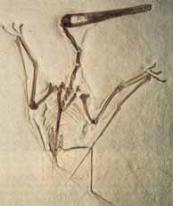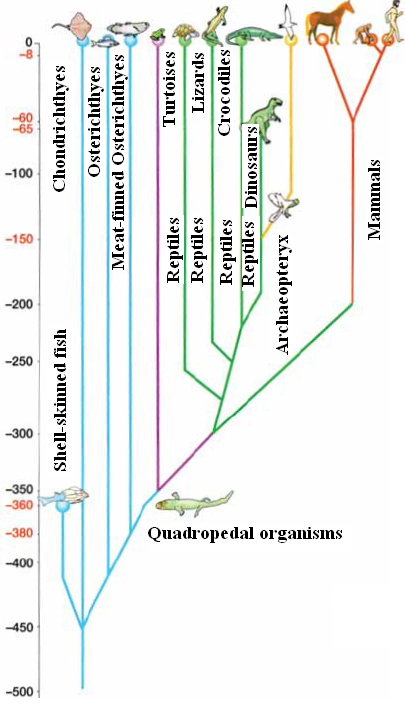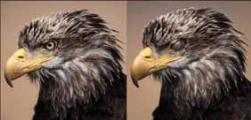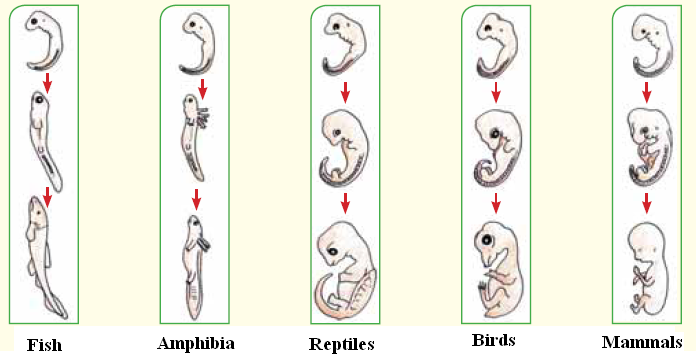
Intermediate fossil
Intermediate fossil: Fossil which has the characteristics of two consecutive classes

Example: Archaeopteryx fossil (intermediate link between
birds and reptiles)
Archaeopteryx fossil has many characteristics of birds,
such as the existence of feather, wings and beaks
Archaeopteryx fossil has also some characteristics of
reptiles, such as the existence of teeth in the beak, bony
vertebrae in tail and claws in wings Fig. (15) Archaeopteryx
![]()
We studied in last chapter that living organisms are ordered in phyla from the simple to complex organisms. Development is graduated from one phylum to another. We can say that the arrangement of living organisms is like a tree, which begins from the simple to complex. This lead to the discovery of gaps in living organisms arrangement
Scientists closed these gaps by putting some extinct organisms (intermediate fossils) and modern organisms in the living organisms arrangement, such as:-
Archaeopteryx: Closed the gap between reptiles and birds
Lung fish: Closed the gap between fish and Amphibia, as lung fish breathe in water by gills, and breath in case of drought by a structure resembling simple lungs
Cladogram (Evolution tree)
 It describes the relation
between different species and groups of living organisms
It describes the relation
between different species and groups of living organisms
Fig. (16) Evolution tree of vertebrates
From the previous Cladogram we conclude that:-
- The ancestry of living organisms (Quadropedal organisms) appeared 360 million years ago
- All the groups of the Cladogram have vertebral column
Cladogram summarizes the relation between species and consecutive groups, beginning from mutual ancestries. It allows us determine the degree of similarity between different species
![]()
There are similarities and differences between living organisms, which are used in classification. Animals are classified into vertebrates and invertebrates according to the presence of vertebral column
Vertebrates are similar in the existence of skull containing the brain, and the existence of blood cells carrying hemoglobin
Limbs of vertebrates are similar in structure, but they have different shapes to suit the function
The similarity in vertebrates structure proved that they are descended from common origin
![]()
The proof on the evolution of vertebrates from common origin is that there are organs which used to perform necessary functions in old ancestries. When they became useless, they disappeared or diminished.
Examples of vestigial structures:-
1- Appendix: A part of large intestine which secretes enzymes to digest cellulose in plants. So, it doesn't exist in carnivorous animals (lions), it is large in herbivorous (rabbits)and diminished in human, it is thought that it was large in old human who used to eat plants
2- Muscles that move ears: large in most mammals (Ex. dogs – horses) and diminished in human
3- Coccyx vertebrae: They are vertebrae with which vertebral column ends, they form the tails of lot of animals. They are diminished in human
4 -
Third eyelid (nictitating membrane):A
transparent
-
Third eyelid (nictitating membrane):A
transparent
membrane which appears obviously in the eyes of
birds and reptiles to protect them from sands carried
by the wind. This eyelid is diminished in mammals
and doesn't exist in humans
![]()
Living organisms are similar in many vital functions, such as:-
1- Cytoplasm: All living organisms cells have protoplasm in which anabolism and catabolism processes takes place in an identical manner
2- Cell division: Cell division occurs in the same steps in all living organisms under the control of nucleus (which carries hereditary material identically in the form of chromosomes)
3- Wastes: Living organisms are similar in excreting wastes in the form of nitrogenous compounds, but the kind of compound differs according to the kind of animal:-
- Fish get rid of nitrogenous wastes in the form of ammonia through gills, because it dissolves in water quickly
- Amphibians and mammals get rid of nitrogenous wastes in the form of urea through kidneys, as urea dissolves quickly in urine water
- Reptiles and birds get rid of nitrogenous waster in the form of uric acid with faeces, because uric acid is insoluble in water
4- Hormones: Vertebrates are similar in the existence of glands responsible for regulating vital processes in body (Digestion, growth, reproduction…etc)
![]()
All organisms which reproduce sexually begin their life as a single cell called zygote

Fig. (17) Stages of fetal growth in vertebrates
The fetuses of the previous vertebrates pass through the same stage, where gill slits are formed, and heart is formed from two chambers (one auricle and one ventricle). As growth goes on, changes begin to appear
Fetal similarity in mammals proved that they are descended from common origin
Bird fetus gets rid of nitrogenous wastes in the 1st stage (inside the egg) in the form of ammonia (like fish). Then, it begins getting rid of these wastes in the form of urea (like Amphibia). When growth is over, it gets rid of these wastes in the form of uric acid
![]()
Molecular biology science is from the modern evidences of evolution theory, as hereditary material in all living organisms is composed of the same building units (nucleotides). Which proved that all organisms are descended from a common ancestry.
![]()
A- Natural reserves (protectorates)
Natural reserve: An area of nature preserving particular types of plants and animals which is surrounded by a barrier to be protected from environmental conditions and human activities
Importance of natural reserves:-
1- They protect the endangered species from extinction
2- They protect natural resources and biological diversity
3- They keep the environmental balance constant
4- They can be used in touristic purposes
Natural reserves in the Arabic Republic of Egypt
There are 30 natural reserves in Egypt
In South Sinai:-
- Ras Muhammad protectorate
- Tiran and Sanafir Islands
- Saint Catherine protectorate
- Abu Galum protectorate
- Napq protectorate
In North Sinai:-
- Zaranik protectorate
In Red Sea governorate:-
- Gebel Elba
In Matrouh governorate:-
- Alameed protectorate
In Portsaid governorate:-
- Ashtoum El Gamil protectorate
- Tennis island
In Aswan governorate:-
- Wadi Al-Alaqi protectorate
In fayoum governorate:-
- Wadi Elrayan protectorate
- Lake Moeris
B- Determination of fossils age
Age of fossil are determined by measuring the ratio of radioactive carbon in it. The first to use this technique was the American chemist Willard Libby in 1949. He calculated the age of organic substances (Hair, bones, plants, wood, natural textiles…etc) approximately
How to determine the age using radioactive carbon
Radioactive carbon is the radioactive isotope of carbon (carbon-12)
When cosmic radiation reaches the atmosphere everyday, it causes the reaction of carbon-12 and carbon-14 with oxygen forming carbon dioxide gas.
Plants absorb both carbon-12 and carbon-14 during photosynthesis process
The ratios of carbon-12 and carbon-14 are equal to those in the atmosphere in this time.
When living organisms die, the ratio of carbon-12 doesn't change, while the ratio of carbon-14 changes (due to its decay) without being replaced
Half time of carbon-14 equals 5730 years. In other words, half the amount of carbon-14 decays to its half after 5730 years
So, we can measure the amount of carbon-14 in a petrified tree and that in an alive tree, which gives us its age approximately
![]()
Fossils: The remains or traces of living organisms which lived in old ages and were buried after their death in sedimentary rock
Index fossil: Fossil of living organisms on which we depend in the comparison between the layers of sedimentary rocks in order to determine their relative ages
Mould: Fossil which carries the internal details of the solid skeleton of living organism after its death.
Cast: Fossil which an organism leaves after its death, which decays in soft rocks.
Printings: The shape which an organism leaves on soft rocks in its life.
Fossil record: Complete set of fossils which records the evolution of some living organisms during geological ages, such as fossil records of horses and elephants
Intermediate fossil: Fossil which has the characteristics of two consecutive classes
Protectorate: An area of nature preserving particular types of plants and animals which is surrounded by a barrier to be protected from environmental conditions and human activities
![]()
1- The importance of fossils
Because:-
1- Determination of the geological age of rocks by determining the age of fossils in them
2- Recognizing the landmarks of old environment
3- Proving the evolution of living organisms
4- Comparing between rocks layers by index fossils
5- Drawing old geographical maps
2- The fossils of some animals weren't formed
Because of factors which prevented the occurrence of petrifaction process which are:-
- Lack of water in porous layers of sedimentary rocks, which causes the decay of living organism
- The occurrence of volcanoes and earthquakes, which causes the deformation and breakage of fossils
3- Archaeopteryx fossils in the intermediate link between birds and reptiles
Because Archaeopteryx fossil has many characteristics of birds,
such as the existence of feather, wings and beaks. It has also some characteristics of reptiles, such as the existence of teeth in the beak, bony
vertebrae in tail and claws in wings
4- The importance of Cladogram (Evolution tree)
Because it describes the relation between species and consecutive groups, beginning from mutual ancestries. It also allows us determine the degree of similarity between different species
5- The existence of fully-grown appendix in rabbits and such herbivorous animals
Because rabbits feed on plants basically. So, appendix is fully grown in order to secrete enzymes which digest cellulose in these plants
6- Appendix in humans is diminished (from vestigial organs)
Because it was fully-grown in old man who used to feed on plants, but now it became useless in human, so it diminished
7- Birds and reptiles have nictitating membrane (third eyelid) in their eyes
To protect their eyes from the sand carried by the wind
8- Mammals forelimbs are modified
In order to be adapted to their environment and functions
9- Molecular biology give an evidence on the validity of evolution theory
Because molecular biology states that hereditary material in all living organisms is composed of the same building units (nucleotides). Which proved that all organisms are descended from a common origin.
10- The importance of protectorates
Because:-
1- They protect the endangered species from extinction
2- They protect natural resources and biological diversity
3- They keep the environmental balance constant
4- They can be used in touristic purposes
![]()
1- Choose the correct answer
1-…….. is an example on fossils of entire organisms
A- Ammonite fossil B- Amber C- Mammoth fossil D- Dinosaur bones
2- ……… is an example of moulds
A- Petrified forest B- Fish fossil C- Ammonite fossil D- Mammoth fossil
3- ……… is an example on casts
A- Petrified forest B- Fish fossil C- Ammonite fossil D- Mammoth fossil
4- ………….. is the intermediate link between birds and reptiles
A- Lung fish B- Archaeopteryx C- Dinosaurs D- Shield fish
5- ………. is the intermediate link between fish and amphibians
A- Lung fish B- Archaeopteryx C- Dinosaurs D- Shield fish
6- ………. is an example of vestigial organs in human
A- Appendix B- Duodenum C- Cerebrum D- Uterus
2- Write the scientific term
1- The remains or traces of living organisms which lived in old ages and were buried after their death in sedimentary rock
2- Fossil of living organisms on which we depend in the comparison between the layers of sedimentary rocks in order to determine their relative ages
3- Fossil which carries the internal details of the solid skeleton of living organism after its death.
4- Fossil which an organism leaves after its death, which decays in soft rocks.
5- The shape which an organism leaves on soft rocks in its life.
6- Complete set of fossils which records the evolution of some living organisms during geological ages, such as fossil records of horses and elephants
7- Fossil which has the characteristics of two consecutive classes
8- Area of nature preserving particular types of plants and animals which is surrounded by a barrier to be protected from environmental conditions and human activities
![]()
1- Choose the correct answer
1- Mammoth fossil 2- Ammonite fish 3- Fish fossil 4- Archaeopteryx
5- Lung fish 6- Appendix
2- Write the scientific term
1- Fossils 2- Index fossil 3- Mould 4- Cast 5- Printing 6- Fossil record
7- Intermediate fossil 8- Protectorate
